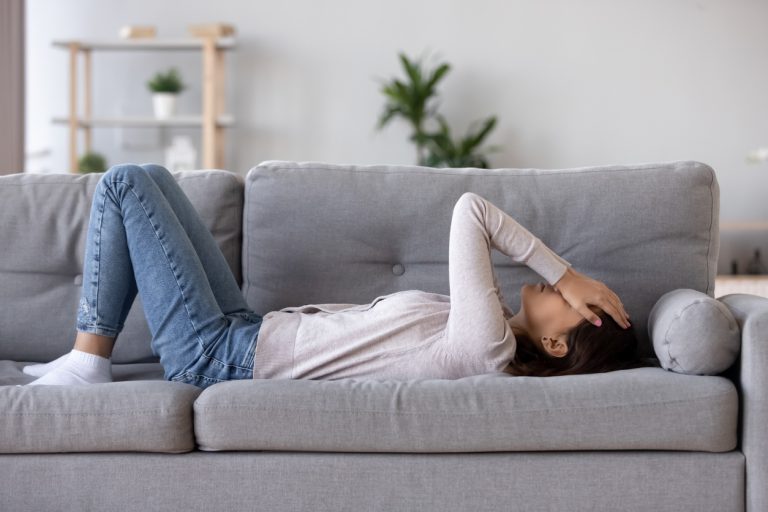If you’ve ever experienced a migraine, you’ll already know that it’s much more than a regular headache. Migraines are marked by a particularly intense throbbing pain, usually on one side of the head or over one eye. Migraine sufferers may also experience other symptoms in addition to the headache, such as disturbed vision or sensory issues. To top it off, nausea, vomiting and diarrhea are also common with migraine attacks.
For many living with migraines, even basic daily activities like walking or climbing the stairs become impossible during an attack. Some say that any physical or cognitive exertion whatsoever seems to make the pain feel worse.
For such a debilitating condition, it feels a little out of place to refer to migraine ‘coping mechanisms’, but that’s exactly what helps migraine sufferers get through. If you’ve been struggling with migraine headaches, the first thing you need to do is learn more about your condition — what type of migraine headaches do you tend to suffer with, and why? Then, you can start to regain control over your attacks and look forward to living a happier life.
Let’s start at the beginning: what causes a migraine?
Truth is, doctors are not sure exactly what causes a migraine, but it seems that both genetics and environment play a role. For example, you are more likely to suffer with migraines if either of your parents do. However, it normally takes some external factor to trigger an attack.
These triggers vary for different people. For some, it is a particular type of food or drink, especially alcohol. Others are more prone to migraines during periods of stress or anxiety. Sometimes hormonal changes, such as the menstrual cycle or menopause, can lead to migraines too.
Whatever causes the attack in the first place, migraine sufferers will surely all agree: the physical effects of the condition can be truly life-changing. And the idea that you may pass your migraines onto your children, or suffer a bout during a particularly busy time in your life, can have knock-on effects to your overall mood as well.
“I have probably never felt real joy.”
As distressing and debilitating as the immediate symptoms of a migraine are, many people find the deeper impact on lifestyle, emotional health and general well-being hardest to deal with.
You should know that you’re not alone if you find yourself struggling with feelings of anxiety, loss-of-control or low mood as a result of your migraines.
One woman, interviewed as part of a study into what it’s like to live with migraine, summed it up as: “The worry about having a migraine attack takes away the joy of planning something joyful. You think ‘This is going to be fun!’ but then you think I might get a migraine. I have probably never felt real joy because of always having this in the back of my mind; it is always present.”
If you notice your mood level drop during an attack, make sure you speak to your doctor as soon as you can.
Take control by becoming an expert on your own condition
The sense of helplessness and uncertainty about when an attack will happen, and what exactly it will involve, are major issues for many migraine sufferers.
This is why the medical profession is trying to empower individuals affected by migraines to become experts on their own condition. After all, everyone experiences migraines in their own way. People have different migraine types, different triggers, different frequencies of attack, and so on.
Gaining a deeper understanding of your own migraine patterns can help you take control both practically and psychologically. It will help you to communicate more clearly with your healthcare providers and ensure you receive the right treatment for your needs.
Understanding your own migraine triggers can enable you to make lifestyle changes that minimize the risk or severity of attacks. You may also experience a greater sense of self-confidence and control over your condition as you gain insight into what is happening and why.
Which type of migraine do you tend to have?
Knowing which migraine type you generally suffer from can help you manage your own health more effectively. Remember: not all forms of migraine are treated in the same way or caused by the same factors.
Below is a list of the major types of migraine to help you think through which sort you may be suffering from. Of course, this is not a substitute for medical advice, and if you have any symptoms you are concerned about, you should always talk to your doctor.
1. Migraine without aura
- Headache attacks which last between 4 and 72 hours
- At least two of the following symptoms: one-sided pain, throbbing pain, medium to severe pain, the pain gets worse when trying to move
- Other symptoms during the headache include nausea, vomiting and sensitivity to sound and light
Of all the different migraine types, migraine without aura is by far the most prevalent. Sometimes known as the common migraine, it affects between 70 and 90 percent of migraine sufferers.
You will know you are suffering with a migraine rather than a regular headache because of the intensity of the pain, which often pulsates over an eye or on one side of the head. You may experience other symptoms like nausea, vomiting and sensitivity to sound and light. However, this type of migraine does not start with aura, i. e. visual or other sensory symptoms before the headache.
Migraine headaches can have a devastating effect on your quality of life, especially if you suffer from frequent attacks. It’s important that even if you have the “most common type” of migraine, you don’t try to suffer in silence. Definitely speak with your doctor about different medical and lifestyle changes that can help you manage your symptoms.
2. Migraine with aura
- A migraine as described above which is preceded by visual or other sensory disturbances
- Sensory disturbances develop over at least 5 minutes and last for up to an hour
- Disturbances can include seeing flashing lights, blindspots, tunnel vision, zigzag lines or in rare cases speech problems, one-sided paralysis or a tingling sensation like pins and needles
If you experience disturbed vision just before a migraine, it could be that you’re among the 10 to 30 percent of migraine sufferers who experience migraine with aura attacks.
Aura is the name for a group of neurological symptoms that primarily affect the vision and that precede migraine headaches. They normally develop over a period over at least 5 minutes and last for up to an hour. These symptoms typically occur shortly before the headache begins.
Different people experience aura in different ways. You may see flashing lights, zigzags, have a sense of tunnel vision or another type of visual distortion. Aura can also affect other senses, so you may feel pins and needles in your limbs, dizziness or you may even develop speech or hearing difficulties.
As you’d imagine, aura can be a frightening experience — especially if it’s the first time you’ve had it and you don’t know what’s happening. If you’ve never suffered from aura before, you should get any new symptoms accompanying a headache checked out promptly. There are other conditions that present in a similar way to migraine with aura, and you want to rule these out.
Once you know that you’re dealing with migraine aura, you can be assured that the visual and sensory symptoms are temporary and normally fully resolve within an hour.
3. Migraine with brainstem aura
A rare subtype of migraine with aura which – next to the usual aura symptoms – includes at least two of the following:
- Speaking difficulties
- Dizziness
- Tinnitus
- Hearing loss
- Double vision
Migraine with brainstem aura is a specific type of migraine with aura, where the symptoms are believed to originate from the lower part of the brain, connected to the spinal cord. This being said, migraines with brainstem aura do not usually involve motor weakness.
Brainstem aura symptoms, like other types of visual aura symptoms, usually develop gradually and precede a migraine headache. Brainstem aura symptoms, however, often last for longer than the more common visual aura symptoms.
Most people experience their first episode of migraine with brainstem aura in their late teens or early twenties. It is quite common for people affected by brainstem aura to also suffer from migraines with typical visual aura. Developing brainstem aura after the age of 50 is rare, so if it happens there’s no reason to worry immediately, but you should seek medical attention to rule out more serious conditions, such as stroke.
4. Hemiplegic migraine
A subtype of migraine with aura which – next to the usual aura symptoms – includes the following symptoms:
- Physical weakness which usually last less than 72 hours, but can in some cases last over several weeks
- Visual, sensory and/or speech disturbances
The word hemiplegic usually means paralysis, however most attacks are characterised by physical weakness.
The weakness is accompanied by other symptoms, such as confusion, speech and vision problems. Since these symptoms are similar to those of a stroke, you should make sure you get urgent medical treatment if you have not suffered with hemiplegic migraines before or if there is anything unusual about the symptoms.
Hemiplegic symptoms associated with migraine usually pass within 72 hours, but in rare cases they can last for several weeks. They usually precede a migraine headache, but they can sometimes develop after a headache, or by themselves without a headache.
There are two subtypes within the general group of hemiplegic migraines:
Familial Hemiplegic Migraine (FHM): If you suffer from hemiplegic migraines, there’s a strong chance that one of your parents was also affected by the condition. Research shows that 50 percent of children with a parent with hemiplegic migraines will go on to develop the same type of migraine themselves. This is known as familial hemiplegic migraine (FHM).
Sporadic Hemiplegic Migraine (SHM): There are some instances where individuals start experiencing hemiplegic migraine without any hereditary basis. Sometimes this is due to a gene mutation, but many times the cause is unknown. This type of migraine is called sporadic hemiplegic migraine (SHM).

5. Retinal migraine
- Similar to migraine with aura, but visual disturbances are isolated to one eye only
- Women under the age of 40 most commonly affected, together with people who have a family history of migraine
Retinal migraine is another subtype of migraine with aura. It is very similar to typical visual aura, but it tends to involve disturbed vision in one eye only, where visual aura usually affects both eyes. Retinal migraine can cause temporary blindness in one eye, or it can present as flashes of light.
If you’re not sure whether you’re experiencing visual aura or retinal migraine, you can try covering one eye to see whether both eyes are affected or just one.
Retinal migraines are caused by changes in the flow of blood in the retina or behind the eyes. As with typical visual aura, symptoms develop gradually, last for less than an hour and are normally followed by a migraine headache.
6. Vestibular migraine
- Causes balance issues
- Attacks may only last a few minutes, or stretch on for days
- Can be mistakenly diagnosed when inner ear issues are the real cause
Vestibular migraine, as the name suggests, refers to a migraine that involves difficulties with balance. If you suffer from this type of migraine, you may experience vertigo, a sense of dizziness or spinning. You may also suffer from a lack of spatial orientation. Symptoms can last for as little as a few minutes or as much as 72 hours and may be accompanied by visual aura before resulting in a headache.
Before diagnosing you with vestibular migraine, your doctor will want to rule out any other medical condition that could be causing your symptoms. For example, diseases and disorders of the inner ear often lead to difficulties with balance.
If you are diagnosed with vestibular migraine, your doctor may advise you to take two different types of medication — one to manage your headache pain and a separate one to help with the vestibular symptoms.
7. Migraine with aura without headache
- A rare type of migraine with aura where the aura symptoms are not followed by a headache
- Most common in older patients with a history of migraines
For most people, the word migraine is synonymous with a bad headache. So, it may be surprising to hear that you can have a migraine without a headache.
Although it is relatively rare, you can experience migraine with aura without a migraine headache. So, if you’re suffering from aura symptoms but there is no headache afterwards, it may be that you have this type of migraine.
Migraine without headache is most common in older people who used to suffer from regular migraines when they were younger.
Without the pain of a headache, these sorts of migraines tend to be less disruptive and distressing for those affected. However, there are certain activities, such as driving, that it is best to avoid while you are experiencing aura symptoms.
8. Chronic migraine
- 15 or more headache days per month, of which at least 8 are migraine days, over a period of 3 or more consecutive months
Chronic migraine is defined as a headache that occurs for 15 or more days per month, of which at least 8 are migraines, over a period of 3 or more consecutive months.
Chronic migraine affects less than 1 percent of the population. However, if you are one of the individuals affected, it can be extremely debilitating.
Some people living with chronic pain, including migraines, describe it as a big psychological challenge. As one migraine sufferer interviewed about her experiences explained: “You learn to live with it and you do not know what life would be without it, but it is like permanently wearing a backpack, which is tough, you must always consider the possibility not being able to do things.”
Migraine support groups can be helpful places to share your experiences and talk to other people dealing with similar issues. Journaling is another useful tool to help you track your own condition and express your emotional journey.
9. Menstrual migraine
- Symptoms flare up in sync with the menstrual cycle, usually lasting 3-4 days
- Migraine without aura is most common, but migraine with aura can occur too
- Attacks will cease after menopause
Menstrual migraine, as the name suggests, is migraine triggered by hormonal changes connected to the menstrual cycle.
It is thought that menstrual migraines are caused by falling levels of estrogen and the release of prostaglandin in the first 48 hours of menstruation. As such, these migraines normally start just before the monthly menstruation and last for the first three or four days of your bleed.
Menstrual migraines do not have their own distinctive symptoms. Any migraine type can be triggered by the menstrual cycle, although migraine without aura is most common.
If you think you are suffering with menstrual migraines it’s worth documenting your symptoms in a journal and, over time, cross-referencing this with your menstrual cycle.

How to live with migraines
Finding the most effective way to manage your migraines depends largely on the type of migraine you have and how severely it affects you. If you experience attacks only once in a while, you will probably not need to take preventive medication or make significant lifestyle changes.
If your migraines happen frequently and are very debilitating, you may need to make some intentional changes. Here are some strategies for managing your condition:
Find out which treatment works best for you
There are many different migraine treatments on the market, so finding the right one for you can take a bit of time. What’s more, you may need to combine different treatments to deal with different aspects of the migraine, e.g. pain medication for the headache and anti-nausea medication for the vomiting. Of course, it’s good practice to speak with your doctor before trying a new treatment.
Plan ahead
If you suffer with frequent and unpredictable attacks, it’s often helpful to think through what you will do if you get a migraine in different settings. For example, there may be a quiet room in your workplace where you can rest if an attack comes on during office hours. If you are involved in a competitive team sport, you might want to tell your teammates and identify someone who could stand in for you if necessary.
Start journaling
Keeping a record of when you get migraines and what triggers them can give you valuable insights into your own condition. The journaling process can also help you off-load some of the more emotional effects of your migraine attacks.
Practice relaxation
Remember: a migraine is not a life sentence
Although migraine can be a painful and distressing condition, it’s normally possible to gain some level of control through the right treatment and lifestyle changes. As far as possible, try to stay positive and focus on the things you enjoy.
Your life, and your identity, is about much more than just your migraines.




